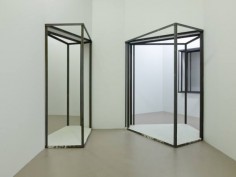OSCAR TUAZON
오스카 투아
奥斯卡·图阿松
Sensory Spaces
source: theguardian
Oscar Tuazon’s art may be vulnerable, but you’d never guess. His sculpture-cum-architecture has used raw slabs of concrete, steel and untreated wooden beams, bark-encrusted tree trunks and weighty metal chains. For his current installation, My Mistake, at London’s ICA, the artist has assembled what looks like a massive climbing frame from tree-size pine beams. Almost too big for the gallery, one girder even bursts through a wall.
Born in 1975, Tuazon grew up outside Seattle, coming of age watching bands like Mudhoney and Nirvana (one spell in the mosh pit was so frenzied he once broke his leg). Having graduated from the elite Independent Study Program at New York’s Whitney Museum in 2003, he cut his teeth working for renowned extremist Vito Acconci, a performance artist and poet-turned-architect. After moving to Paris in 2007, Tuazon set up the gallery castillo/corrales with a group of artist and curator friends, and the past three years have seen his constructions of wood and concrete take over exhibition spaces across Europe.
Inspired by what he calls “outlaw architecture”, Tuazon channels the extreme DIY and freethinking of hippy survivalists who decide to go off-grid. If his industrial materials suggest a minimalistic stress on concept over making, he’s just as interested in the physical side of sculpture. He is not afraid to get his hands dirty: working with riggers and technicians, he starts off with a sketch, chain-sawing wood, developing ideas and patching up problems on the hoof. From the impromptu-looking concrete slab that intersects the two-storey wooden frame of his 2009 work, Bend It Till It Breaks, to the neon strip light glowing two and a half metres up an untreated tree-trunk buttressed by planks in I Wanna Live, his structures have a rough-shod, improvised feel.
As muscular and uncompromising as it can first appear, Tuazon’s work is ephemeral. Like the hippy idealists defining their environment on their own terms, the artist will always have to pack up and move on. Yet while they stand, pushing at walls and ceilings and taking over space, these makeshift constructions remind us of the imaginative struggle to make what we want of the world, no matter what rules and boundaries seem to press down on us.
Why We Like Him: For Kodiak, a 2008 installation including a water tank, window, wood beam and lantern, created with his brother Eli Hansen and based on the 10 days they spent living rough on a wintry Alaskan island. We also love his 2007 book, Un-house – The Architecture of Dwelling Portably, which chronicles his experiences on the road while tracking down nomads in the forests of Oregon.
Freestyle: Since they were teenagers, Tuazon and his bro have covered themselves in homemade tattoos, making up the designs as they go along.
.
.
.
.
.
.
.
.
source: namocorg
作为新项目“感觉空间”的第一个展览,他在这个几近200平方米的空间场地内安排了几件雕塑般的建构物(sculptural constructions)。艺术家将建筑和雕塑的风格糅合,从而让观众对于该空间的感知错位:那种古典博物馆的“观看”体验变成了一种“经历”。


